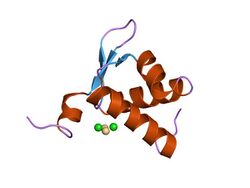Biology:Adenosine deaminase z-alpha domain
| Adenosine deaminase z-alpha domain | |||||||||
|---|---|---|---|---|---|---|---|---|---|
 Crystal structure of the zb domain from the RNA editing enzyme ADAR1 | |||||||||
| Identifiers | |||||||||
| Symbol | z-alpha | ||||||||
| Pfam | PF02295 | ||||||||
| Pfam clan | CL0123 | ||||||||
| InterPro | IPR000607 | ||||||||
| SCOP2 | 1qgp / SCOPe / SUPFAM | ||||||||
| |||||||||
In molecular biology, the protein domain Adenosine deaminase z-alpha domain refers to an evolutionary conserved protein domain. This family consists of the N-terminus and thus the z-alpha domain of double-stranded RNA-specific adenosine deaminase (ADAR), an RNA-editing enzyme. The z-alpha domain is a Z-DNA binding domain, and binding of this region to B-DNA has been shown to be disfavoured by steric hindrance.[1]
Function
Double-stranded RNA-specific adenosine deaminase (EC) converts multiple adenosines to inosines and creates I/U mismatched base pairs in double-helical RNA substrates without apparent sequence specificity. DRADA has been found to modify adenosines in AU-rich regions more frequently, probably due to the relative ease of melting A/U base pairs compared to G/C base pairs. The protein functions to modify viral RNA genomes, and may be responsible for hypermutation of certain negative-stranded viruses. DRADA edits the mRNAs for the glutamate receptor subunits by site-selective adenosine deamination. The DRADA repeat is also found in viral E3 proteins, which contain a double-stranded RNA-binding domain.
Examples
Genes encoding proteins containing this domain include ADAR and ZBP1.
References
- ↑ "The solution structure of the Zalpha domain of the human RNA editing enzyme ADAR1 reveals a prepositioned binding surface for Z-DNA". Proc. Natl. Acad. Sci. U.S.A. 96 (22): 12465–70. October 1999. doi:10.1073/pnas.96.22.12465. PMID 10535945. Bibcode: 1999PNAS...9612465S.
 |

